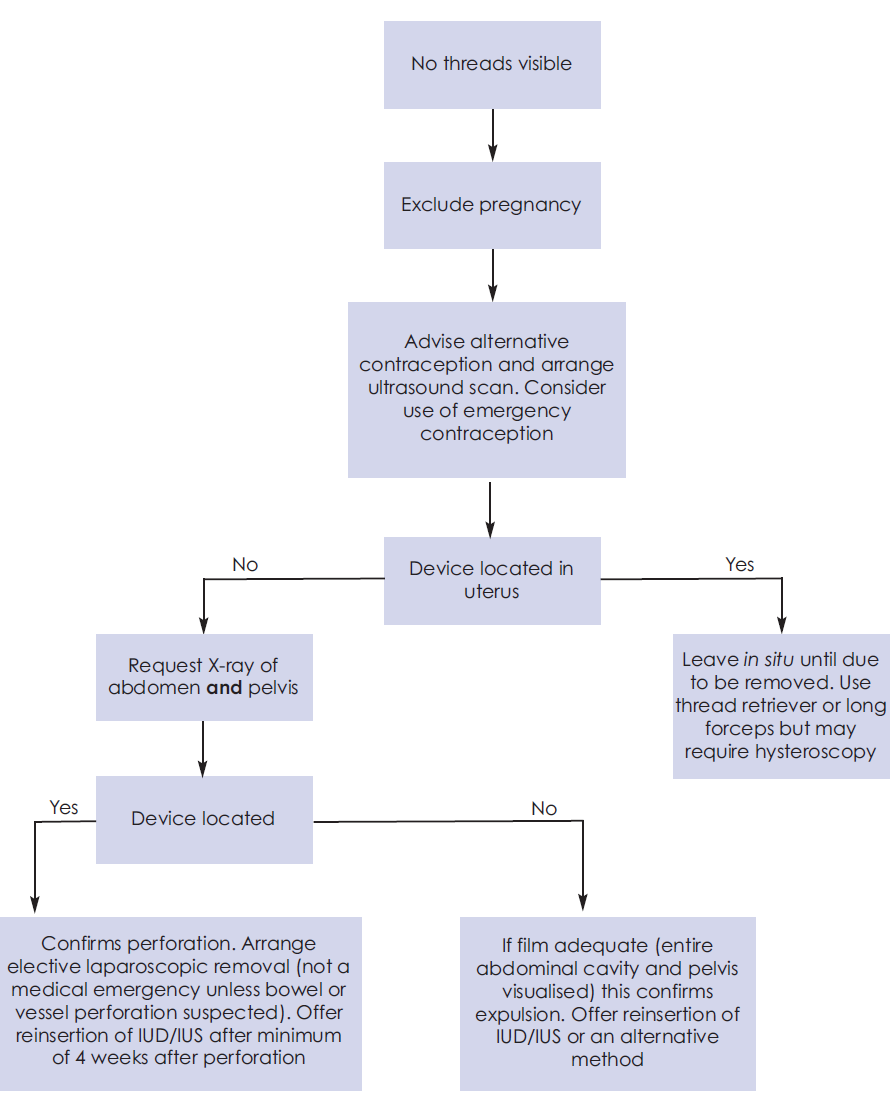lost threads (IUCD)
Last edited 07/2019
- if 'lost threads'
- Advise women to use another method (condoms or abstinence) until medical
review. Exclude pregnancy. Consider the need for emergency hormonal contraception
- if no threads are seen and uterine placement of the intrauterine method
cannot be confirmed clinically, an ultrasound scan should be arranged
to locate the device and alternative contraception recommended until this
information is available
- if device located in uterus then leave in situ until due to be removed.
Use thread retriever or long forceps but may require hysteroscopy
- if device located in uterus then leave in situ until due to be removed.
Use thread retriever or long forceps but may require hysteroscopy
- if an ultrasound scan cannot locate the intrauterine method and there
is no definite evidence of expulsion, plain abdominal X-ray and pelvic
X-rays should be arranged to identify an extrauterine device
- if the intrauterine method is not confirmed on an ultrasound scan clinicians
should not assume it has been expelled until a negative X-rays have been
obtained (unless the woman has witnessed expulsion)
- if device located on abdominal/pelvic Xray
- confirms perforation
- arrange elective laparoscopic removal (not a medical emergency unless bowel or vessel perforation suspected). Offer reinsertion of IUCD after minimum of 4 weeks after perforation
- Advise women to use another method (condoms or abstinence) until medical
review. Exclude pregnancy. Consider the need for emergency hormonal contraception
Summary algorithm management of women with no intrauterine contraceptive threads visible on speculum examination. IUD, intrauterine device; IUS, intrauterine system

Notes:
- if the IUC device is confirmed to be within the uterine cavity, the woman
can be reassured and the device left in situ. If the device is to be removed,
then thread retrievers (such as Retrievette or Emmett) or Spencer Wells forceps
can be used to facilitate this process
- is not advisable to use a thread retriever or forceps blindly without
first confirming the intrauterine location of the device and excluding
pregnancy
- if the IUC device cannot be removed easily, individuals should be referred for specialist review and then for removal using IUD removal forceps under local anaesthetic. Ultrasound guidance may be helpful and hysteroscopic removal is occasionally required
- when an IUC device is due to be removed or replaced, in general it should
not be left in situ because of 'lost threads'
- cases of actinomyces-like organisms (ALOs) and pyometra have very occasionally occurred in postmenopausal women with IUDs. Careful discussion is required to balance the risks of surgical removal against the risks of infection from retained IUC, or if the woman refuses to have the IUC removed
- is not advisable to use a thread retriever or forceps blindly without
first confirming the intrauterine location of the device and excluding
pregnancy
Reference:
- FSRH Guidance (November 2007) Intrauterine Contraception.
- FSRH Guidance (April 2015) Intrauterine Contraception